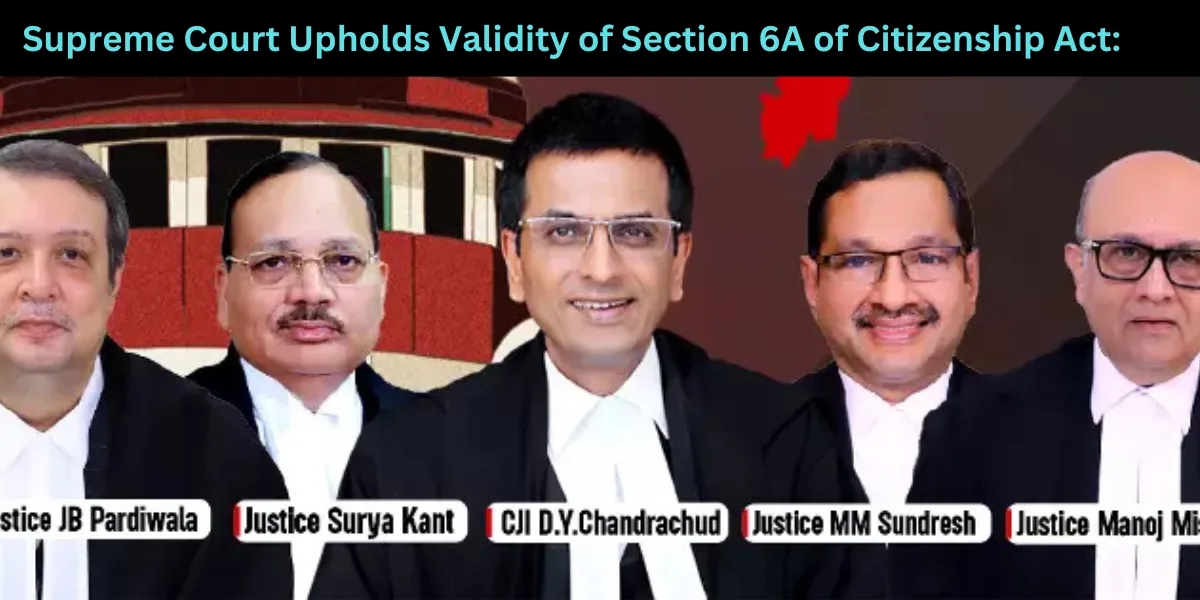In a significant ruling on October 17, 2024, the Constitution Bench of the Supreme Court upheld the constitutional validity of Section 6A of the Citizenship Act, 1955, by a 4:1 majority. This decision relates to the complex issue of granting Indian citizenship to illegal immigrants in Assam, particularly those who migrated from Bangladesh during tumultuous times. The majority opinion, delivered by Chief Justice D.Y. Chandrachud, emphasized the necessity of balancing humanitarian needs with the socio-economic implications of migration.
Background of Section 6A
Section 6A was introduced as part of the Citizenship Act in furtherance of the Assam Accord, a political settlement signed on August 15, 1985, between the then Rajiv Gandhi government and leaders of the Assam Movement. This Accord aimed to address the concerns of the Assamese people regarding illegal immigration and its potential impact on their culture and identity. The backdrop of this legal provision is the six-year-long agitation led by the All Assam Students Union (AASU), which sought to identify and deport illegal immigrants, primarily from Bangladesh.
According to the provisions of Section 6A, individuals who entered Assam before January 1, 1966, and have been “ordinarily resident” in the state, are granted the same rights and obligations as Indian citizens. Those who entered between January 1, 1966, and March 25, 1971, are similarly granted citizenship but face a 10-year voting restriction.
The Majority Opinion
Chief Justice Chandrachud, leading the majority, stated that Section 6A provides a necessary balance between humanitarian concerns and the economic consequences of migration. He argued that the cut-off dates established in the provision, particularly the significance of January 1, 1966, are reasonable and not arbitrary. The judgment asserts that the law is neither under-inclusive nor over-inclusive, meaning it does not unjustly exclude any group nor does it grant excessive rights that could disrupt local dynamics.
Justice Surya Kant, who contributed to the majority opinion, emphasized the importance of fraternity and coexistence among diverse ethnic groups within the state. He noted that the detection of foreigners is a complex process, and the onus of proving one’s citizenship for those who entered during the 1966-71 period has often been misconstrued. Furthermore, he highlighted that the challenges posed by illegal immigration are primarily due to insufficient implementation of existing laws rather than the provisions of Section 6A.
The Dissenting Opinion
In stark contrast, Justice J.B. Pardiwala, the sole dissenter, argued that Section 6A has become unconstitutional over time. He acknowledged that while the provision may have been valid at its inception, it fails to meet its original objectives today. Justice Pardiwala pointed out that the classification created by Section 6A—differentiating between immigrants who arrived before and after January 1, 1966—has lost its relevance due to the lack of timely enforcement regarding the identification and deportation of illegal immigrants.
Justice Pardiwala expressed concern that the absence of a temporal limit in Section 6A allows for indefinite applicability, which could perpetuate the very issues the provision aimed to address. He stressed that the historical context that necessitated Section 6A has changed, and the original intent behind its creation—to ensure a structured and efficient detection process—has not been realized. As a result, he concluded that the provision has become manifestly arbitrary and should be deemed unconstitutional.
Latest Posts
- Indian Army Ordnance Corps (AOC) Recruitment 2024: Apply Now for 723 Posts
- CBSE Class X and XII Date Sheet for Board Examinations PDF – 2025
- Android 16 Developer Preview 1: Key Features, Timeline, and Eligible Devices
- Netflix to Launch “Squid Game: Unleashed” Mobile Game on December 17, 2024
- JEE Main 2025 Application Forms Released: Direct Link Apply Now
Implications of the Ruling
The Supreme Court’s decision to uphold Section 6A carries significant implications for Assam and its residents. Proponents of the ruling argue that it provides necessary legal protection to long-standing residents who may otherwise face uncertainty about their citizenship status. The judgment seeks to reassure those who have lived in Assam for decades that their rights are safeguarded, particularly in light of ongoing concerns over illegal immigration.
However, critics of the ruling, particularly those aligned with Justice Pardiwala’s dissent, warn that without effective measures to manage and monitor illegal immigration, the social fabric of Assam may be at risk. They argue that the existing provisions fail to address the realities of contemporary migration patterns and could lead to further tensions between communities.
Summary
The Supreme Court’s ruling on Section 6A of the Citizenship Act encapsulates the intricate balance between legal provisions and the socio-political realities of Assam. While the majority opinion underscores the necessity of upholding the law to protect the rights of individuals in Assam, the dissenting view raises crucial questions about the efficacy and relevance of such provisions in the current context.
As Assam continues to navigate the challenges posed by migration and citizenship, the Supreme Court’s decision serves as a pivotal reference point for policymakers, legal experts, and the public alike. The discourse surrounding immigration and citizenship in Assam remains vibrant and contentious, reflecting the broader complexities of identity, culture, and belonging in a rapidly changing world.



